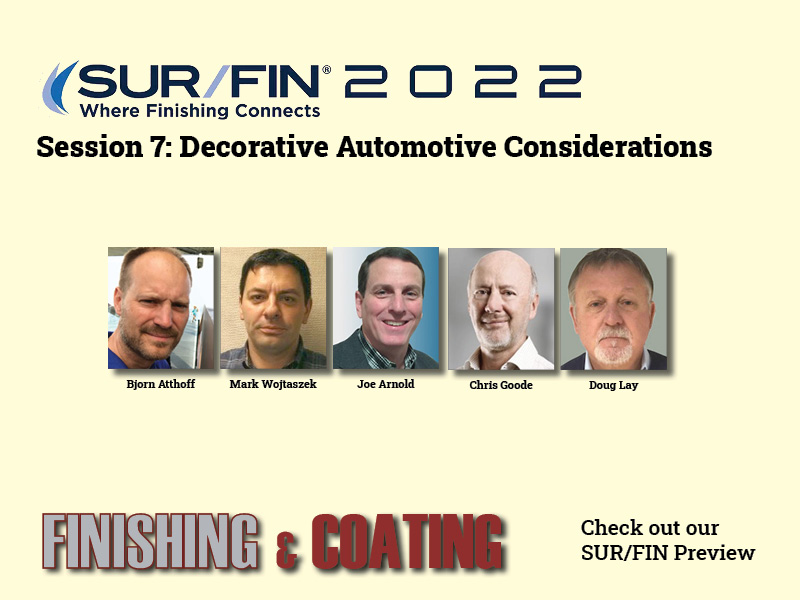Session 7 at the NASF SUR/FIN Technical Conference will be on “Decorative Automotive Considerations.”
Here are the abstracts for the presentations on June 8. Please visit www.nasfsurfin.com for information on registering for the event:
Session 7: Decorative Automotive Considerations
Session Chairs Ling Hao, Lacks Enterprises, and Dan Hooks, Los Alamos Nat’l Labs
8:30 – 9:00: Molecular Surface Alteration to Allow for Plating on Plastics — Björn Atthoff, Cuptronic Technology AB
 CBM, Covalent Bonded Metallization, a chemical surface modification on a molecular level. Adhesion promotion that allows for metal plating on a multitude of polymers (incl. non-plating grade) without the use of hexavalent chromium. This technology also increases the number of platable polymers and furthermore it is more forgiving to injection molding parameters. CBM is also possible technique to use within the PCB industry, especially for production of high frequency electronic, both PCBs and antennas CBM, Covalent Bonded Metallization. This emerging technology allows for metallization of polymeric surfaces. Same process for e.g. PCB, POP, Automotive and Sanitary. It is an adhesion promotion technology that after treatment of the pure plastics enables the usage of conventional plating chemistry. However, for the POP industry it also removes the need for pre etching with hexavalent chromium. Plastic surfaces in general are hydrophobic and not particularly susceptible to electrochemical deposition of metals. To overcome these disadvantageous properties the plastic substrate needs to be pretreated. Current techniques utilize etching with metal salts, acids and heat to deteriorate the chemical structure of the surface layer in the plastic. The CBM technology described here achieve hydrophilicity and electrochemical environment, but in an additive manner. Parts are coated with a monomer solution followed by exposure to an energy source. This results in creation/alteration of the molecules on the surface of the plastic. This method is referred to as "grafting" and the added molecules as "graft polymers". The graft polymers have hydrophilic properties, as well as electrochemical properties suitable for metal deposition. The solution is an engineered chemistry with initiators and catalysts that minimize the energy required for the modification of the surface. Following the CBM process, normal Palladium catalysts for electroless metal deposition might be used, but also Silver catalysts have been showed to work well with this system. The CBM allows for a multitude of polymers, including non- plating grade, to be used, i.e., it enables the selection of polymers for desired product properties instead of plating ability. Furthermore, the injection molding parameters are not as crucial when plating with the CBM process. Regarding PCB industry, the surface structure is somewhat irrelevant for the CBM process, it allows for very smooth substrate surface which with increasing frequency becomes more important
CBM, Covalent Bonded Metallization, a chemical surface modification on a molecular level. Adhesion promotion that allows for metal plating on a multitude of polymers (incl. non-plating grade) without the use of hexavalent chromium. This technology also increases the number of platable polymers and furthermore it is more forgiving to injection molding parameters. CBM is also possible technique to use within the PCB industry, especially for production of high frequency electronic, both PCBs and antennas CBM, Covalent Bonded Metallization. This emerging technology allows for metallization of polymeric surfaces. Same process for e.g. PCB, POP, Automotive and Sanitary. It is an adhesion promotion technology that after treatment of the pure plastics enables the usage of conventional plating chemistry. However, for the POP industry it also removes the need for pre etching with hexavalent chromium. Plastic surfaces in general are hydrophobic and not particularly susceptible to electrochemical deposition of metals. To overcome these disadvantageous properties the plastic substrate needs to be pretreated. Current techniques utilize etching with metal salts, acids and heat to deteriorate the chemical structure of the surface layer in the plastic. The CBM technology described here achieve hydrophilicity and electrochemical environment, but in an additive manner. Parts are coated with a monomer solution followed by exposure to an energy source. This results in creation/alteration of the molecules on the surface of the plastic. This method is referred to as "grafting" and the added molecules as "graft polymers". The graft polymers have hydrophilic properties, as well as electrochemical properties suitable for metal deposition. The solution is an engineered chemistry with initiators and catalysts that minimize the energy required for the modification of the surface. Following the CBM process, normal Palladium catalysts for electroless metal deposition might be used, but also Silver catalysts have been showed to work well with this system. The CBM allows for a multitude of polymers, including non- plating grade, to be used, i.e., it enables the selection of polymers for desired product properties instead of plating ability. Furthermore, the injection molding parameters are not as crucial when plating with the CBM process. Regarding PCB industry, the surface structure is somewhat irrelevant for the CBM process, it allows for very smooth substrate surface which with increasing frequency becomes more important
9:00 – 9:30: Plastic Article Surface Preparation for Subsequent Metallization to Achieve Adequate Adhesion to Substrate — Mark Wojtaszek, MacDermid Enthone
 Metal additive manufacturing (AM) is being pursued as manufacturing technique in order to shorten The topography layer and remaining structure of the plastic surface after etching or mechanical blasting can be viewed subjectively, as clearly defined, or even lacking the necessary backbone to achieve adequate bonding to that substrate. Utilizing different analytical tools we will comprehensively display an array of plastic rendered surfaces, offer up subjective reviews, while going into a thorough comparison on depth of topography achieved by means of measuring Ra values while also discussing, filler removal, cavities achieved, and patterns seen.
Metal additive manufacturing (AM) is being pursued as manufacturing technique in order to shorten The topography layer and remaining structure of the plastic surface after etching or mechanical blasting can be viewed subjectively, as clearly defined, or even lacking the necessary backbone to achieve adequate bonding to that substrate. Utilizing different analytical tools we will comprehensively display an array of plastic rendered surfaces, offer up subjective reviews, while going into a thorough comparison on depth of topography achieved by means of measuring Ra values while also discussing, filler removal, cavities achieved, and patterns seen.
9:30 – 10:00: Frequently Contemplated and Never Fully Answered Questions Regarding Plating on Plastics — Joe Arnold, Atotech USA
 OEM specifications with respect to part performance are well documented and quantified which result in a high-quality product. Process parameters resulting in final part performance are known but not always fully understood. The purpose of this paper will be to dive deeper into the understanding of processes and parameters that influence part performance and why. Specific topics dealing with polymer selection, part fabrication, chemical etching, adhesion mechanisms, catalyst adsorption and others will be investigated. The use of state-of-the-art analytical equipment will help show just how and why those parameters are effective and what might be done to improve.
OEM specifications with respect to part performance are well documented and quantified which result in a high-quality product. Process parameters resulting in final part performance are known but not always fully understood. The purpose of this paper will be to dive deeper into the understanding of processes and parameters that influence part performance and why. Specific topics dealing with polymer selection, part fabrication, chemical etching, adhesion mechanisms, catalyst adsorption and others will be investigated. The use of state-of-the-art analytical equipment will help show just how and why those parameters are effective and what might be done to improve.
10:00 – 10:30: Cirrus Paint-Free Colour: Robust Coloured Coatings on (Light Metal) Alloys — Chris Goode, Cirrus Materials Science
 Cirrus Paint-Free Colour is an extension of Cirrus Hybrid technology which develops nanostructured aluminium surfaces to support adherent functional coating deposition. Unlike the conventional approaches, which use paints or dyes to create colour, Cirrus Paint-Free ColourTM develops visible light resonant nanostructures using a low temperature and low power process that eliminates virtually 100% of VOCs. Building on Hybrid technology, the tightly interlocked nanostructured alumina and metal deposits are much more adherent than conventional paint. The nanostructures are tunable to produce a wide range of vibrant colours from a thin coating, typically between 3 and 15 microns which provides good corrosion protection and scratch resistance. Cirrus Paint-Free Colour for aluminium is 75% thinner, lighter and five times more energy efficient than traditional painted surfaces and offers a disruptive new sustainable coating system for light metal alloys and 3D-printed components. This presentation provides an update on paint free colour technology development.
Cirrus Paint-Free Colour is an extension of Cirrus Hybrid technology which develops nanostructured aluminium surfaces to support adherent functional coating deposition. Unlike the conventional approaches, which use paints or dyes to create colour, Cirrus Paint-Free ColourTM develops visible light resonant nanostructures using a low temperature and low power process that eliminates virtually 100% of VOCs. Building on Hybrid technology, the tightly interlocked nanostructured alumina and metal deposits are much more adherent than conventional paint. The nanostructures are tunable to produce a wide range of vibrant colours from a thin coating, typically between 3 and 15 microns which provides good corrosion protection and scratch resistance. Cirrus Paint-Free Colour for aluminium is 75% thinner, lighter and five times more energy efficient than traditional painted surfaces and offers a disruptive new sustainable coating system for light metal alloys and 3D-printed components. This presentation provides an update on paint free colour technology development.
10:30 – 11:00: Building a Sustainable Future in Decorative Systems — Doug Lay, MacDermid Enthone
 Current and emerging environmental regulations have a significant impact on plating-on-plastics (POP) and Decorative Coatings (DECO) applicators. The anticipated regulations will cause further restrictions of plating chemistries. This will pose new challenges to develop processes that meet stringent OEM performance standards while also meeting regulatory requirements for worker safety and the environment. To ensure compliance with these pending regulations, MacDermid Enthone has taken the lead to develop critical technologies for Plastic Substrates that do not contain chromium (VI) compounds. These technologies are generically referred to as “chrome-free etches” and decorative trivalent chromium.
Current and emerging environmental regulations have a significant impact on plating-on-plastics (POP) and Decorative Coatings (DECO) applicators. The anticipated regulations will cause further restrictions of plating chemistries. This will pose new challenges to develop processes that meet stringent OEM performance standards while also meeting regulatory requirements for worker safety and the environment. To ensure compliance with these pending regulations, MacDermid Enthone has taken the lead to develop critical technologies for Plastic Substrates that do not contain chromium (VI) compounds. These technologies are generically referred to as “chrome-free etches” and decorative trivalent chromium.
11:00 – 11:30: Liquid Crystal Polymer Metallization — Feng Liu, DuPont Electronics and Industrial
Liquid Crystal Polymer (LCP) has long been used as a high-performance thermoplastic due to its mechanical strength at high temperature and its chemical inertness. More recently, however, its electrical properties at mmWave frequencies are driving demand in cutting edge electronics, where the relatively low dielectric constant and low and stable dissipation factor are key characteristics. Molded LCP parts are used in a growing number of electronics applications including antennae and high frequency printed circuit board substrates, where a robust and reliable surface metallization is required. Many existing processes for metallizing LCP with high glass and/or mineral filler contents utilize sandblasting to roughen the surface to achieve adequate metal adhesion. Although this can produce adherent metal, it is neither consistent nor uniform, does not work for complex geometries, and for many electronic applications it is unsuitable. This presentation will describe the development and optimization of the Teleposit 8000 LCP Metallization Process; an all chemical process which delivers a highly reliable metal finish while eliminating the need for sandblasting. Following the activation and metallization, the substrates may then be finished according to specification with a variety of electroplated solderable or corrosion resistant finishes.
11:30 – 12:00: Novel Surface Finishing on Magnesium Alloys — Chris Goode, Cirrus Materials Science
 A recent surface finishing innovation from Cirrus Materials Science, Mg DefenderTM, offers a sustainable magnesium coating technology that reduces the cost, energy consumption, and coating thickness required to protect magnesium components. Cirrus Mg DefenderTM employs a proprietary low voltage Plasma Electrolytic Oxidation (PEO) process to deposit a tightly bonded protective layer to any magnesium surface. Cirrus Mg DefenderTM operates at less than 5% of traditional PEO process power while producing a surface that provides outstanding corrosion protection. Doping the Mg DefenderTM bath with either carbon and/or nitrogen compounds which, under the influence of the arc temperatures introduce carbides and/or nitrides directly into the developing surface, achieves surfaces with higher hardness (>875HV) and greater wear resistance. Mg DefenderTM surfaces also support direct deposition of secondary functional coatings including electro or auto catalytic metallic coatings and electro deposited or traditional polymer surfaces, which tightly interlock to the PEO surface producing outstanding adhesion. Such secondary layers can provide important functional characteristics, including electrical conductivity, wear resistance, lubricity and/or decorative aspects, which support a plethora of applications. The presentation provides an update on this novel magnesium coating technology which extends the opportunities for magnesium applications.
A recent surface finishing innovation from Cirrus Materials Science, Mg DefenderTM, offers a sustainable magnesium coating technology that reduces the cost, energy consumption, and coating thickness required to protect magnesium components. Cirrus Mg DefenderTM employs a proprietary low voltage Plasma Electrolytic Oxidation (PEO) process to deposit a tightly bonded protective layer to any magnesium surface. Cirrus Mg DefenderTM operates at less than 5% of traditional PEO process power while producing a surface that provides outstanding corrosion protection. Doping the Mg DefenderTM bath with either carbon and/or nitrogen compounds which, under the influence of the arc temperatures introduce carbides and/or nitrides directly into the developing surface, achieves surfaces with higher hardness (>875HV) and greater wear resistance. Mg DefenderTM surfaces also support direct deposition of secondary functional coatings including electro or auto catalytic metallic coatings and electro deposited or traditional polymer surfaces, which tightly interlock to the PEO surface producing outstanding adhesion. Such secondary layers can provide important functional characteristics, including electrical conductivity, wear resistance, lubricity and/or decorative aspects, which support a plethora of applications. The presentation provides an update on this novel magnesium coating technology which extends the opportunities for magnesium applications.



































